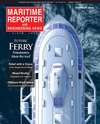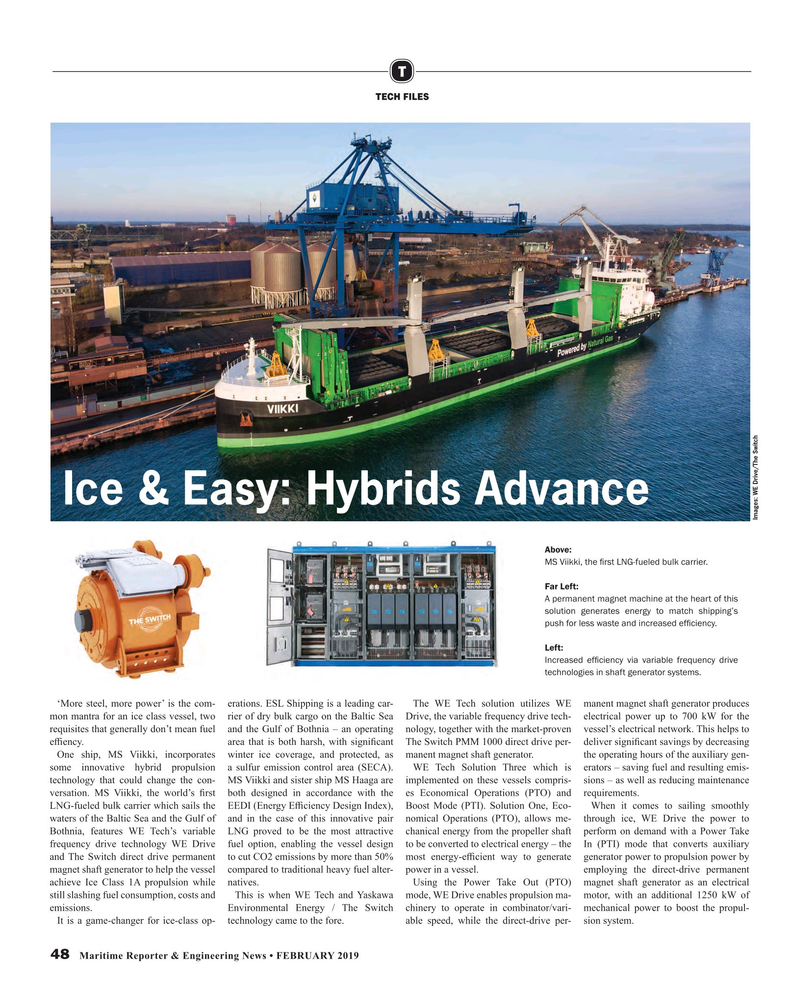
Page 48: of Maritime Reporter Magazine (February 2019)
Ferry Builders
Read this page in Pdf, Flash or Html5 edition of February 2019 Maritime Reporter Magazine
T
TECH FILES
Ice & Easy: Hybrids Advance
Images: WE Drive/The Switch
Above:
MS Viikki, the frst LNG-fueled bulk carrier.
Far Left:
A permanent magnet machine at the heart of this solution generates energy to match shipping’s push for less waste and increased effciency.
Left:
Increased effciency via variable frequency drive technologies in shaft generator systems.
‘More steel, more power’ is the com- erations. ESL Shipping is a leading car- The WE Tech solution utilizes WE manent magnet shaft generator produces mon mantra for an ice class vessel, two rier of dry bulk cargo on the Baltic Sea Drive, the variable frequency drive tech- electrical power up to 700 kW for the requisites that generally don’t mean fuel and the Gulf of Bothnia – an operating nology, together with the market-proven vessel’s electrical network. This helps to efency. area that is both harsh, with signifcant The Switch PMM 1000 direct drive per- deliver signifcant savings by decreasing
One ship, MS Viikki, incorporates winter ice coverage, and protected, as manent magnet shaft generator. the operating hours of the auxiliary gen- some innovative hybrid propulsion a sulfur emission control area (SECA). WE Tech Solution Three which is erators – saving fuel and resulting emis- technology that could change the con- MS Viikki and sister ship MS Haaga are implemented on these vessels compris- sions – as well as reducing maintenance versation. MS Viikki, the world’s frst both designed in accordance with the es Economical Operations (PTO) and requirements.
LNG-fueled bulk carrier which sails the EEDI (Energy Efciency Design Index), Boost Mode (PTI). Solution One, Eco- When it comes to sailing smoothly waters of the Baltic Sea and the Gulf of and in the case of this innovative pair nomical Operations (PTO), allows me- through ice, WE Drive the power to
Bothnia, features WE Tech’s variable LNG proved to be the most attractive chanical energy from the propeller shaft perform on demand with a Power Take frequency drive technology WE Drive fuel option, enabling the vessel design to be converted to electrical energy – the In (PTI) mode that converts auxiliary and The Switch direct drive permanent to cut CO2 emissions by more than 50% most energy-efcient way to generate generator power to propulsion power by magnet shaft generator to help the vessel compared to traditional heavy fuel alter- power in a vessel. employing the direct-drive permanent achieve Ice Class 1A propulsion while natives. Using the Power Take Out (PTO) magnet shaft generator as an electrical still slashing fuel consumption, costs and This is when WE Tech and Yaskawa mode, WE Drive enables propulsion ma- motor, with an additional 1250 kW of emissions. Environmental Energy / The Switch chinery to operate in combinator/vari- mechanical power to boost the propul-
It is a game-changer for ice-class op- technology came to the fore. able speed, while the direct-drive per- sion system.
48 Maritime Reporter & Engineering News • FEBRUARY 2019

 47
47

 49
49
